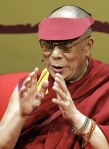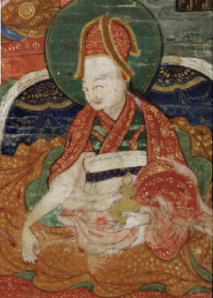When the Dalai Lama speaks out against the practice of Dorje Shugden, he often describes how he came to renounce his own practice of this deity, a practice he engaged in for a quarter-century. In these speeches, he inevitably mentions his own “thorough research.” Due to this reference, repeated over and over again, most people already inclined to believe the Dalai Lama are mollified, and are therefore disinclined to look into the matter further.
often describes how he came to renounce his own practice of this deity, a practice he engaged in for a quarter-century. In these speeches, he inevitably mentions his own “thorough research.” Due to this reference, repeated over and over again, most people already inclined to believe the Dalai Lama are mollified, and are therefore disinclined to look into the matter further.
As an example, consider this introduction on the Dalai Lama’s own website…
His Holiness the Dalai Lama’s Advice Concerning Dolgyal (Shugden)
Following long and careful investigations, His Holiness the Dalai Lama strongly discourages Tibetan Buddhists from propitiating the fierce spirit known as Dolgyal (Shugden)….
and from the Dalai Lama’s talk at Lehigh University in July 2008.
During the Fifth Dalai Lama this problem started. From 1951 to the early 70’s, I myself was a worshipper of this spirit, so actually, previously, I was also one of them….Then around early 70’s..using different sort of methods to investigate, also reading the biographies of past many great masters, mainly the lamas of the yellow hat sect, …suppose if this Shugden is truly reliable, most of the great lamas after the fifth Dalai Lama, then I think must practice….but this is not the case. So….I developed some doubt. Then…thorough investigation, then it became clear.
So, what are the results of all this thorough research? What did the Dalai Lama discover amongst the thousands of works written by the great masters of the Tibetan Buddhist tradition?
Let’s take a look.
Three of the seven “historical references” listed on the Dalai Lama’s website refer to works that do not even mention Dorje Shugden. Of the remaining references, one is by Je Pabongka, one of the most well-know advocates of Dorje Shugden practice. Another is from the Fifth Dalai Lama, although it is believed by many that he later retracted this opinion and changed his view, composing prayers to Dorje Shugden as an enlightened being. The final mention is by one “Jigme Damchoe Gyatso” and is hardly compelling. It is also rejected by several important contemporary Lamas, such as Lama Zopa and Zong Rinpoche.
However, this does not stop the Dalai Lama and his government from citing the many “references” they have found, and representing them as being about Dorje Shugden when they are not.
Trichen Ngawang Chogden

Trichen Ngawang Chogden
This extraordinary master was the root guru of Kelsang Gyatso, the Seventh Dalai Lama. He was also the 54th Ganden Tripa, head of the Gelugpa Tradition. The view that this Lama spoke out against the practice of Dorje Shugden is derived from an episode in his biography written by Chankya Rolpai Dorje, another highly renowned Lama of the Gelug tradition. This Biography, however, never mentions Dorje Shugden. Instead, it talks about a local spirit known as Taktse Gyalpo.
The incident (the Dalai Lama) refers to is narrated in Changya’s biography of Trichen Ngawang Chogden. An evil monk spirit (rgyal.’gong) from Dragsob (brag.sob) who was invoked by some active Lama retired from his monastic office (bla.zur) and a Khamtsen at Ganden. They built a wayside shrine for this spirit in the circumambulation path of Ganden.
Trichen Ngawang Chogden declared this unsuitable. He said that since the time of Je Tsong Khapa and his disciples no worldly spirits were worshiped at his [Ganden] monastery and that in future this would also not be permitted. When that spirit was invoked through an oracle, he said that since the Trichen Rinpoche had said this, he had no choice but to leave and he excused himself and left for Taktse-Shöl. The Lama retired from his monastic office who had relied on that evil spirit died soon after as punishment by Kalarupa [one of Je Tsong Khapa’s protectors]. There is no reference to Dorje Shugden in this passage . The evil monk spirit (rgyal.’gong) was continued to be worshiped as a local deity at the place where he came from.
-Ursula Bernis, Condemned to Silence A Tibetan Identity Crisis, 1999
The reason this spirit from went back to “the place where he came from,” Taktse, an estate not far from Ganden Monastery, is because the spirit referred to in this verse is Taktse Gyalpo, a local spirit said to have been the spirit of a monk who died in bad circumstances.
In this biography master Changya clearly mentions what Trichen Ngawang Chogden has expelled is a ‘Gyalpo’, instead of ‘Dolgyal’. ‘Gyalpo’ is a general name used for all the deities and spirits born as incarnation of former lamas or monks. Therefore hundreds of Gyalpos exist in the Tibetan pantheon, and the term does not only apply to the Dolgyal. The name Dolgyal is a short term for ‘dol gyi gyalpo’. Dol is the name of a place, where the first temple of Dorje Shugden was erected by the 5th Dalai Lama.
-Dorje Shugden Charitable Societey, Chronicle, 2008.
So the original text says “Gyalpo,” and clearly refers to Taktse Gylapo, not Dorje Shugden. Dorje Shugden is not mentioned.
The Samlo department of Ganden monastery took over (the Taktse) estate, and with it, adopted that spirit of the estate as a protector deity of the department. It was then worshipped in the Ganden monastery in their department for some time, until it was expelled by the great master Trichen Ngawang Chogden, who at that time was the throne-holder of Ganden. The spirit was sent back to its estate, where it was worshipped by the villagers until 1959.
-Chronicle
The recognized reincarnation of Trichen Ngawang Chogden was called Trichen Tenpa Rabgya. Tenpa Rabgya was a Geshe lharampa from Sera Monastery, and became the tutor to Changkya Yeshe Tenpai Gyaltsen, the reincarnation of Chankya Rolpai Dorje. Among his teachers were such luminaries as Panchen Lama Palden Yeshe and Kachen Yeshe Gyaltsen. Tenpa Rabgya was a famous practitioner of Dorje Shugden, and wrote praises and rituals for his practice, requesting him to come from the “wisdom Dharmakaya,” clearly indicating his view that Dorje Shugden was a Buddha.



